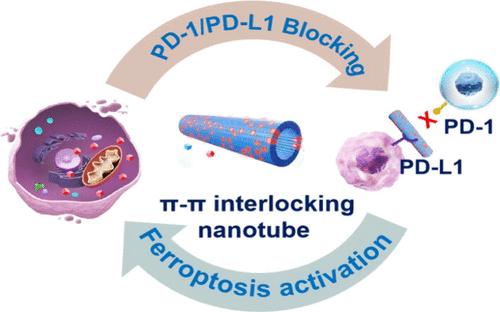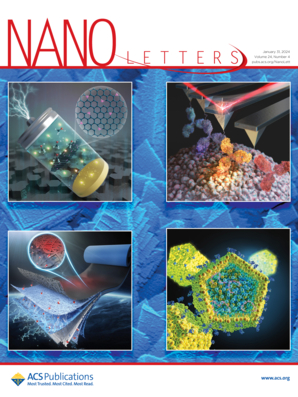利用跨链π-π互锁协同增强免疫检查点阻断和铁凋亡功能
IF 9.6
1区 材料科学
Q1 CHEMISTRY, MULTIDISCIPLINARY
引用次数: 0
摘要
多肽自组装中的非共价键具有动态性质,可选择性地容纳客体分子。然而,目前仍不清楚如何利用共组装来强化主肽,同时改善客体分子的应用缺陷。本研究旨在实现主客体之间的超分子协同作用,进一步拓展杂化纳米结构的功能空间。在此,我们利用β片肽中的芳香区域容纳芳香分子,通过独特的 "跨链π-π交错 "形成长程纳米管(NQ40@AIF)。这种策略不仅能有效稳定共组装,还能协同主分子和客分子的生物功能。此外,由于共组装的 NQ40@AIF 具有化学多样性,因此在肿瘤联合治疗中表现出优势,实现了铁变态反应和免疫检查点阻断的有效协同。这项工作为构建具有复杂功能的多肽纳米结构提供了一种简约的策略。本文章由计算机程序翻译,如有差异,请以英文原文为准。

Harnessing Cross-strand π–π Interlocking for Synergistic Enhancement of Immune Checkpoint Blocking and Ferroptosis
The dynamic nature of noncovalent bonds in peptide self-assembly allows for selective accommodation of guest molecules. However, it remains unclear how to harness coassembly to reinforce the host peptides and simultaneously improve the application defects of guest molecules. This study aims to achieve supramolecular synergy between the host and guest, further expanding the functional space of the hybrid nanostructures. Herein, we utilized the aromatic regions present in β-sheet peptides to accommodate aromatic molecules, forming long-range nanotubes (NQ40@AIF) through a unique ‘cross-strand π–π interlocking’. This strategy not only stabilizes the coassembly effectively but also synergizes the biological functions of the host and guest molecules. Moreover, due to the chemical diversity of the coassembled NQ40@AIF, it exhibits advantages in tumor combination therapy, achieving effective synergy between ferroptosis and immune checkpoint blocking. This work provides a minimalistic strategy for constructing peptide nanostructures with complex functionalities.
求助全文
通过发布文献求助,成功后即可免费获取论文全文。
去求助
来源期刊

Nano Letters
工程技术-材料科学:综合
CiteScore
16.80
自引率
2.80%
发文量
1182
审稿时长
1.4 months
期刊介绍:
Nano Letters serves as a dynamic platform for promptly disseminating original results in fundamental, applied, and emerging research across all facets of nanoscience and nanotechnology. A pivotal criterion for inclusion within Nano Letters is the convergence of at least two different areas or disciplines, ensuring a rich interdisciplinary scope. The journal is dedicated to fostering exploration in diverse areas, including:
- Experimental and theoretical findings on physical, chemical, and biological phenomena at the nanoscale
- Synthesis, characterization, and processing of organic, inorganic, polymer, and hybrid nanomaterials through physical, chemical, and biological methodologies
- Modeling and simulation of synthetic, assembly, and interaction processes
- Realization of integrated nanostructures and nano-engineered devices exhibiting advanced performance
- Applications of nanoscale materials in living and environmental systems
Nano Letters is committed to advancing and showcasing groundbreaking research that intersects various domains, fostering innovation and collaboration in the ever-evolving field of nanoscience and nanotechnology.
 求助内容:
求助内容: 应助结果提醒方式:
应助结果提醒方式:


